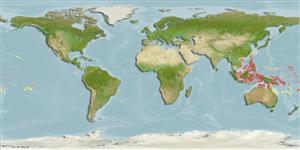Environment: milieu / climate zone / depth range / distribution range
Ökologie
seewasser riff-verbunden; tiefenbereich 0 - 12 m (Ref. 9710). Tropical
Western Central Pacific: Indonesia, New Guinea, Solomon Islands and Palau in Micronesia.
Size / Gewicht / Alter
Maturity: Lm ? range ? - ? cm
Max length : 11.0 cm TL Männchen/unbestimmt; (Ref. 48636)
Rückenflossenstacheln (insgesamt) : 12; Rückenflossenweichstrahlen (insgesamt) : 17 - 19; Afterflossenstacheln: 2; Afterflossenweichstrahlen: 17 - 20. Identified by the red spots over the back and sides towards the tail, and the large breast spot (Ref. 48636).
Facultative air-breathing (Ref. 126274); Adults are found solitary on coral outcrops (Ref. 90102). They inhabit shallow lagoon reefs, on algal covered rocks and rubble (Ref. 9710). Feed on algae growing at the coral bases. Oviparous. Eggs are demersal and adhesive (Ref. 205), and are attached to the substrate via a filamentous, adhesive pad or pedestal (Ref. 94114). Larvae are planktonic, often found in shallow, coastal waters (Ref. 94114). Maximum depth reported by Ref. 48636.
Life cycle and mating behavior
Maturities | Fortpflanzung | Spawnings | Egg(s) | Fecundities | Larven
Oviparous, distinct pairing (Ref. 205).
Myers, R.F., 1991. Micronesian reef fishes. Second Ed. Coral Graphics, Barrigada, Guam. 298 p. (Ref. 1602)
IUCN Rote Liste Status (Ref. 130435)
Bedrohung für Menschen
Harmless
Nutzung durch Menschen
Tools
Zusatzinformationen
Download XML
Internet Quellen
Estimates based on models
Preferred temperature (Ref.
123201): 27.4 - 29.3, mean 28.8 °C (based on 1360 cells).
Phylogenetic diversity index (Ref.
82804): PD
50 = 0.5001 [Uniqueness, from 0.5 = low to 2.0 = high].
Bayesian length-weight: a=0.01072 (0.00480 - 0.02393), b=3.01 (2.82 - 3.20), in cm total length, based on LWR estimates for this (Sub)family-body shape (Ref.
93245).
Trophic level (Ref.
69278): 2.0 ±0.00 se; based on food items.
Widerstandsfähigkeit (Ref.
120179): hoch, Verdopplung der Population dauert weniger als 15 Monate. (Preliminary K or Fecundity.).
Fishing Vulnerability (Ref.
59153): Low vulnerability (10 of 100).
Nutrients (Ref.
124155): Calcium = 131 [70, 225] mg/100g; Iron = 0.891 [0.529, 1.461] mg/100g; Protein = 18.4 [17.2, 19.5] %; Omega3 = 0.125 [0.075, 0.206] g/100g; Selenium = 20.7 [11.5, 39.8] μg/100g; VitaminA = 113 [33, 391] μg/100g; Zinc = 2.5 [1.7, 3.6] mg/100g (wet weight);
